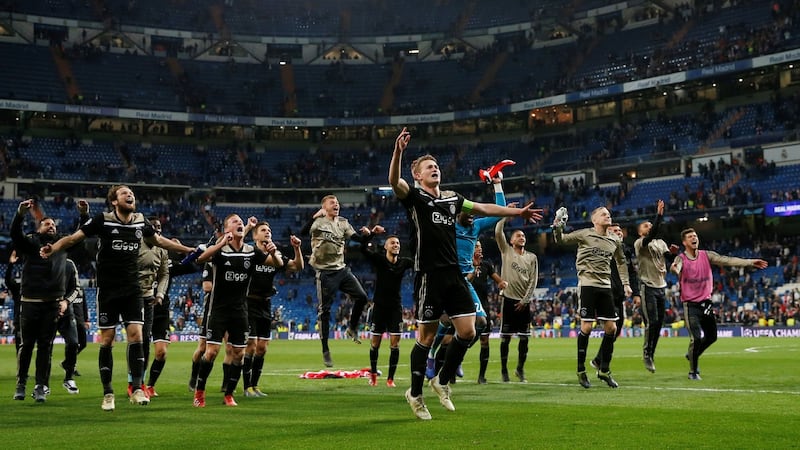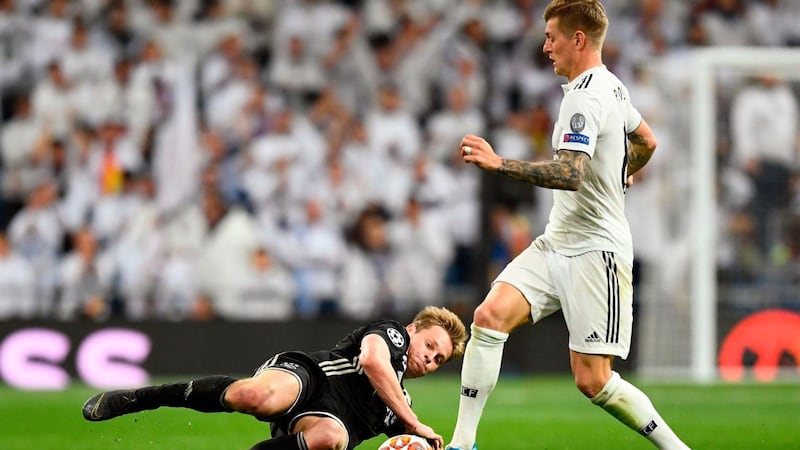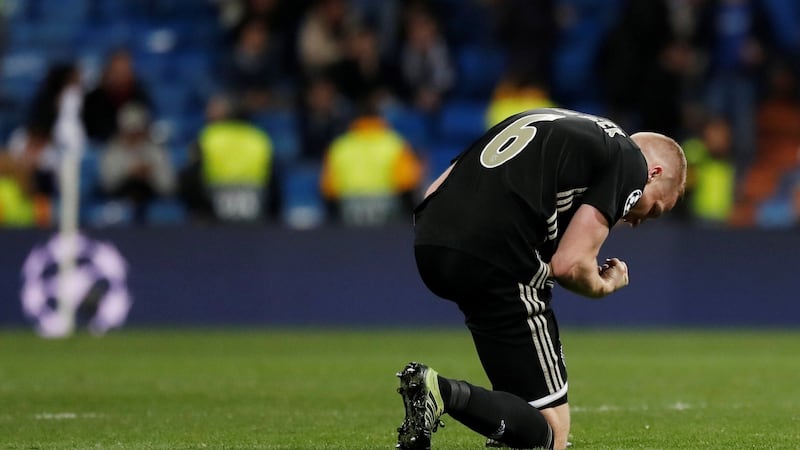Last summer, seven of Ajax's brightest stars were summoned to a room at the Dutch club's training facility. Edwin van der Sar, the goalkeeper-turned-chief-executive, and Marc Overmars, once a jet-heeled wing and now the Ajax sporting director, had a video to show them.
Its premise was simple. Each of the players was paired with an iconic figure from Ajax’s illustrious history, one who shared a position, a nationality or – in one case – a bloodline.
Goalkeeper Andre Onana, in one example, had Van der Sar. Forward Kasper Dolberg got Zlatan Ibrahimovic. Justin Kluivert was juxtaposed with his father, Patrick. Frenkie de Jong had Christian Eriksen, and Matthijs de Ligt was compared to Barry Hulshoff, a defender from Ajax's all-conquering team of the 1970s.
The idea, Van der Sar said, was to “show them how to become a legend at Ajax, and in Holland.” The film was designed to persuade the players, the club’s crown jewels, to resist the temptation to move to England, to Spain, to Italy, for another year or so, to “stay with each other, to win prizes and trophies here and then make the next step.”
Only one of the seven, Kluivert, resisted the emotional overture to follow in his father’s footsteps. He refused to extend his contract and was sold to Roma. At Ajax, they understand why he made that decision – the allure, for a teenager with a famous name, of forging his own path – but when they mention Kluivert now, it is with a hint of regret, a tinge of frustration.
Not because he left, but because he left so soon. “If a player goes after just half a year in the first team, like Kluivert, we are disappointed,” said Said Ouaali, the director of De Toekomst, Ajax’s famed youth academy.

In January, Ajax made another video. This time, it was for public consumption, posted on the club’s social media channels. It was a little more than a minute long, but it showcased all of what Erik ten Hag, Ajax’s current manager, called De Jong’s “special qualities.” It was titled, “Frenkie Futuro,” and was released to celebrate the confirmation of the 21-year-old’s move to Barcelona, set to be completed this summer.
De Jong is the shining light of this Ajax team, a player so promising that he has, more than once, been compared to Johan Cruyff himself. Yet there was no regret at his departure. "Barcelona, enjoy the future, like we do," Ajax wrote on its official Twitter account.
The feelings will be the same, this summer, when De Ligt – a player who has been at Ajax since he was eight – departs, as he is expected to do. A 19-year-old defender who is regarded by some Premier League scouts as the best prospect in any position in world soccer, De Ligt could join his friend at Barcelona, or he might end up at Juventus.
Either way, there will be no sadness, no sense of loss at what might have been. Ten Hag might allow himself to wonder a little, he said, at what could happen if “I could keep them for two or three years,” into their prime, but that is it.
“I will be proud,” he said. “The scouts who found them will be proud. Marc Overmars will be proud. Everyone will be. If they transfer to a big club, you are happy for them.”
This is, of course, what Ajax has always done. Since Cruyff himself left for Barcelona in 1973, it has churned out a stream of talent for others to enjoy: Johan Neeskens, Marco van Basten, Frank Rijkaard, Clarence Seedorf, Edgar Davids, Kluivert, Wesley Sneijder, Rafael van der Vaart, Eriksen, Ibrahimovic, Jan Vertonghen, Luis Suárez. The Ajax alumni list reads like a who's who of modern football.
The formula that has allowed it to do so hangs on the wall in Ten Hag's office, opposite a series of black-and-white portraits of Rinus Michels, the mastermind of the great team of the 1970s; Cruyff, its star; and Louis van Gaal, the man who restored Ajax to the European pinnacle in the 1990s, with a team reared almost entirely at De Toekomst.

Ten Hag laughs when he looks at that wall – “They set you a standard,” he said, blowing out his cheeks – but he is serious when he discusses the Ajacied, a cross between a mission statement and a creed for the club.
These are the traits the club seeks to instil in every player who wears its jersey, or who passes through De Toekomst, as well as its coaches and staff. There are 11 of them; they have been arranged like a team. This being Ajax, they are set out in a 4-3-3 formation. They range from taking responsibility and initiative to remaining disciplined and having fun.
The approach, clearly, works. No team in Europe produces more professional players than Ajax. The club’s figures put it ahead of Partizan Belgrade and Dynamo Kyiv. According to Ouaali, a staggering 86 per cent of players who are at De Toekomst at age 16 will go on to have pro careers.
But that is not to say it has not been adapted, altered, fine-tuned over the years. That process started in 2011, when Cruyff returned to a club that – in Van der Sar’s words – “did not feel like Ajax anymore.” Cruyff and the cadre of former players he brought with him wanted not only to restore the focus on youth development, to shed highly paid, ageing players, but to change the way Ajax worked.
“We focus always on the individual,” Ouaali said. “We don’t think about age groups, like the Dutch federation or like other clubs. It can be hard for coaches because they want results as well – to be successful, to be promoted to the next step up – but we try to find coaches who focus on the development of players, who learn the individual, not the team.”
The club recognised, too, that it had to work faster than before. Players were no longer staying in the Eredivisie until they were 23 or 24; they were leaving at 20 or 21, if not earlier. “At 19, they needed to be ready to play in the first team,” Ten Hag said, “because at 20, they are gone.”
That meant more physical work at younger ages, and an end to players going to school outside Ajax. Now, they study at De Toekomst, so they can maximise the hours they spend in the classroom and on the training field.

Ajax borrowed methods found in Montessori education to mix age groups, and its under-18 team was abolished to “increase pressure on the talent,” Ouaali said.
The club’s second team, Jong Ajax – which plays in Dutch soccer’s second tier – no longer would be filled with senior players; now, most of its members are still in their teenage years. “We had to speed up the process,” Ten Hag said. “They had to be good quicker.”
All of it was a formal acknowledgment of Ajax’s place in the 21st century soccer firmament. It is telling, for example, that Ouaali sees his job, and that of De Toekomst, not as to produce players for the first team, but to produce them for “Ajax, then the Dutch national team, then the top international level.”
The order is important. Ajax is not just about developing players; it is also concerned with winning. Van der Sar, in particular, was keenly aware of the need to keep its proteges long enough to benefit from them.
It is why he has loosened the wage budget enough to make staying around for an extra year or two appealing. It is why the club is seeking to expand its global footprint, opening an office in New York; agreeing to run a youth system at Guangzhou R&F, the Chinese Super League team; finding ways to monetise its name.
De Jong and De Ligt have done what they were asked to do when they watched that video last summer. They might not have won a trophy, but by carrying Ajax to the quarter-finals of the Champions League and ending Real Madrid’s 1,000-day plus reign as European champions, they have “given something back,” as Van der Sar put it.
When they – and possibly other members of the seven – depart, they will go with the best wishes of the club, and then the whole system will start again.
That, after all, is Ajax’s real gift: its ability not to produce one player, or one generation of them, but to keep on going. It is what makes players leaving not only desirable but necessary.
“We have to give the path to the next one,” Van der Sar said. “If players stay too long, the next one cannot play. The whole thing chokes.”
He cited an example from just a couple of years ago. Davy Klaassen was Ajax's captain then. He was 24. The club had high hopes for a young midfielder, Donny van de Beek, but he needed a place to play.
“Donny was saying, ‘Okay, Davy, come on now, it’s your time to go,’” Van der Sar said.
Klaassen did go: to Everton. On Tuesday, Van de Beek was in midfield against Real Madrid at the Bernabéu. Another player, another one off the production line, giving something back. – New York Times











